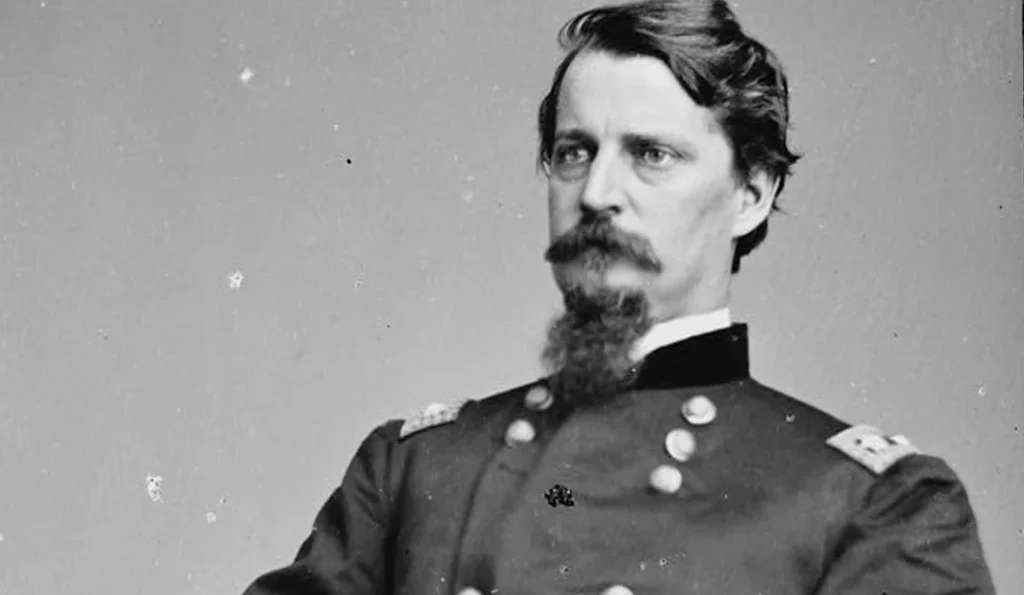February 14, 1824–February 9, 1886
General Winfield Scott Hancock was one of the more successful Union commanders during the American Civil War. In 1880, he also was the Democratic Party’s candidate for President of the United States of America against Republican and Ohioan James Garfield.
Winfield Scott Hancock and his identical twin brother were born on February 14, 1824, in Montgomery Square, Pennsylvania, northwest of Philadelphia. He was named for General Winfield Scott, a prominent American army officer who served in the War of 1812, the Mexican-American War, and the American Civil War. Hancock’s parents were Benjamin Franklin Hancock and Elizabeth Hoxworth Hancock. Hancock received his early education at the Norristown Academy in Norristown, Pennsylvania and in the Norristown public schools. He entered the United States Military in 1840 and graduated in 1844, 18th in his class of 25.
After graduating, Hancock was commissioned as a second lieutenant and stationed in Indian Territory. He later served in Mexico during the Mexican-American War (1846–1848). During that war, he was wounded at the Battle of Churubusco on August 20, 1847, and he was brevetted to first lieutenant for his gallant and meritorious service. After the Mexican-American War, Hancock remained in the army, serving at Fort Snelling, Minnesota and at Jefferson Barracks, St. Louis, Missouri. While serving in St. Louis, Hancock met Almira (“Allie”) Russell, and they married on January 24, 1850. On November 5, 1855, Hancock was promoted to captain and reassigned to Ft. Myers, Florida. Thereafter, he served in Utah and California until the beginning of the American Civil War.
When the Civil War began, Hancock was promoted to brigadier general and placed in command of an infantry brigade in the Army of the Potomac on September 23, 1861. At the;Battle of Williamsburg (May 5, 1862), he earned the nickname “Superb”, by leading a critical counterattack. General George B. McClellan telegraphed to Washington that “Hancock was superb today,” and the name stuck. Hancock became a divisional commander following the mortal wounding of Major General Israel B. Richardson during the Battle of Antietam (September 17, 1862). Soon thereafter, he was promoted to major general of volunteers on November 29, 1862. Hancock was wounded in the abdomen during the Battle of Fredericksburg (December 11–15, 1862), and he was wounded again during the Battle of Chancellorsville (April 30–May 6, 1863). Hancock’s most famous service was as a corps commander at the Battle of Gettysburg (July 1–July 3, 1863), where he made the command decision to defend Cemetery Ridge, bearing the brunt of Major General George Pickett’s unsuccessful charge on July 3rd. Hancock was seriously wounded in the thigh during the Battle of Gettysburg and suffered lingering effects for the remainder of his life. On January 28, 1864 , Hancock was voted the Thanks of Congress for his service at Gettysburg. Following Gettysburg, Hancock continued to serve as a field commander during the Wilderness Campaign (May-June 1864). In 1864, Hancock suffered the only significant defeat of his;military career when;his troops were routed at the Second Battle of Ream’s Station (August 24, 1864). Due to lingering effects of his Gettysburg wound, Hancock resigned his field command in November 1864. Nevertheless, he remained on active duty, and was promoted to brevet major general in the regular army for his service at Spotsylvania, effective March 13, 1865.
After the end of the Civil War, Hancock was assigned to command the Middle Military Department, headquartered in Baltimore, Maryland. While there, he supervised the execution of President Abraham Lincoln’s assassination conspirators (July 7, 1865). In 1866, Hancock was promoted to major general and was transferred to Fort Leavenworth, Kansas, where he briefly commanded of the Military Department of the Missouri. In 1867, Hancock was reassigned to New Orleans, in charge of the Fifth Military District. While serving in New Orleans, Hancock came into disfavor with Congressional Republicans when he issued General Order Number 40 on November 29, 1867. Issued during President Andrew Johnson’s administration, that order eased military oversight and restored civil liberties to white Southerners in the district. The order alarmed blacks and strict Reconstructionists, but it was so popular among Southern Democrats that Hancock received serious consideration for that party’s presidential nomination in 1868. When Ulysses Grant succeeded President Johnson in 1869, Hancock was relieved of his Reconstruction responsibilities and transferred to the relative obscurity of Department of Dakota in the West. Hancock re-emerged in 1872, when he assumed command of the Department of the Atlantic, following the death of General George Meade. In 1880, the Democratic Party nominated Hancock to run against Republican James A. Garfield in that year’s presidential election. Garfield defeated Hancock by fewer than 10,000 votes, the closest popular vote in presidential electoral history. After Garfield’s victory, Hancock continued to serve as commander of the Atlantic Division until his death in 1886. Winfield Scott Hancock died on February 9, 1886, at Governors Island, New York. He is buried in Montgomery Cemetery in West Norton Township, Pennsylvania.
Related Entries
- Battle of Chancellorsville
- Wilderness Campaign
- Battle of Antietam
- Battle of Fredericksburg
- Battle of Gettysburg
- George Brinton McClellan
- George Gordon Meade
- Andrew Johnson
- Army of the Potomac (USA)
- Winfield Scott
- Battle of Williamsburg
- General Orders, No. 316 (U.S. War Department)
- General Orders, No. 256 (U.S. War Department)
- Mexican-American War
